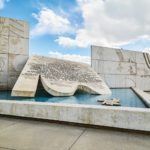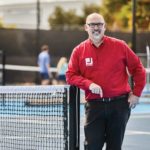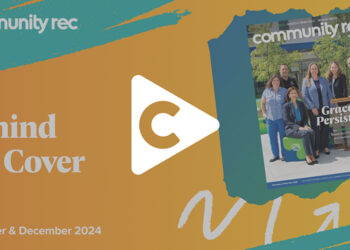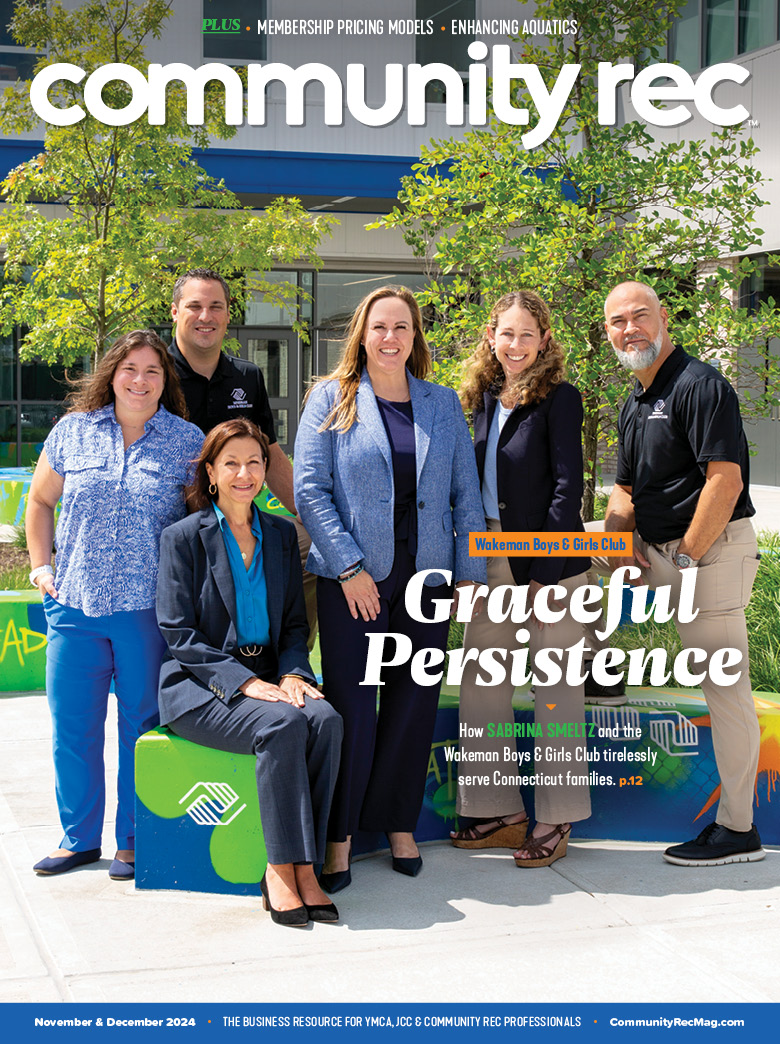If you’re on an afternoon drive in Tucson, Arizona, and find yourself on North Dodge Boulevard on the northeast side of town, you should catch a glimpse of the entrance to what looks like a museum, complete with a reflecting pool and ornate wall art.
This piece of art is a Holocaust memorial, and the building it stands in front of is not a museum — it’s the Tucson Jewish Community Center (the J). Operating since the late 1980s, the Tucson J has been committed to helping its surrounding community attain a higher quality of life.
“We get up in the morning to strengthen and build the community, and the way we do that is by providing high-quality programs that are engaging and meaningful to people,” said Todd Rockoff, the president and CEO of the Tucson J. “Obviously, the evolution of how it’s being done has changed a great deal — some of that is the growth of technology or change in population — but the core remains the same.”
The core of the organization’s mission manifests itself in providing services for all people, covering the full spectrum of wellness. “We want to have something for everybody,” said Amy Dowe, the director of wellness at the Tucson J. “We want to give them the highest quality of service when they’re here, and make them feel like this is a place where their kids can grow up and they can be a part of a community.”
The Tucson J has excelled at creating a welcoming community in which members can find whatever services they need to further their physical, mental, emotional and spiritual wellness. And the inspiration for their programs comes from a concept called the “wellness wheel.”
The Wellness Wheel
“The wellness wheel is a holistic approach to wellness that includes 14 different areas that are a framework to build our programs,” said Jennifer Selco, the director of Jewish life and learning at the Tucson J. “Fitness and health are two of the components, as are cultural, social, artistic, nutrition, inclusion and environmental thinking — just to name a few.”

According to Selco, the thought behind the wellness wheel was that wellness means something different to everyone. With 14 categories (and more, if needed) through which programming ideas can be formulated, the Tucson J will be able to provide the desired holistic wellness experience.
“Wellness is not just being up in the fitness center,” said Dowe. “Wellness is going to lectures we open to the community or attending high-intensity interval training (HIIT) classes. We try to get the community involved as much as possible.”
In fact, wellness takes on a variety of forms. “For some, wellness might mean taking a stroll in our serene sculpture garden,” said Selco. “For others, wellness might be taking a cooking class taught by a Syrian refugee who has made Tucson their permanent home.”
Thanks to the wellness wheel, Rockoff, Selco and the rest of the Tucson J staff have made more intentional programming decisions, and the members are reaping the benefits. “We’re asking how many areas can work together as an ecosystem to provide higher-quality programs with more residual benefits to the participants,” said Rockoff.
Through its holistic slate of offerings, the Tucson J delivers just about any program members of all ages can ask for. This commitment to delivering memorable experiences is exemplified in its most unique offering: a fine art gallery.
The Gallery
Conventional logic might dictate that fine pieces of art and fitness equipment shouldn’t occupy the same space, but for the Tucson J, appreciating art and exploring one’s own artistic ability are just as important to wellness as fitness.
“We’re not just the single-dimensional recreation agency, but a multidimensional one,” said Rockoff. “Art and being artistic are part of that spiritual wellness people can have, so it’s not just a gallery that displays art — although, to be sure, that is something it does — we also try to find exhibits where we can put in some curriculum and use it as a teaching opportunity.”
According to Rockoff, using fine art to formulate educational programs is a critical component of the Tucson J’s offerings, especially those that educate children. “We also offer an art studio where people can create their own art,” he said.
Emphasizing the arts is one of the primary ways the Tucson J educates its members on various art styles and gives them a unique gathering space, while also giving local artists a venue to show off their best work.
To capitalize on its members’ interest in art, the Tucson J created a sculpture garden behind the main building in 2009. This beautiful space promotes tranquility, and is a great place for members to relax after a tough workout, refocus and take in any one of the 40-plus sculptures.
Aside from featuring beautiful works of art, Rockoff and his team have also used the sculpture garden to host fun community events.
“We’ve been able to create a couple of run series — a traditional 1K or 5K — for families, and we’ve wrapped it around with our sculpture garden,” said Rockoff. “We begin and end those experiences in our outdoor sculpture garden, providing an opportunity to learn about our sculptures.”
It may be unorthodox, but the art gallery-fitness facility combination has been a critical component to the Tucson J’s success over the years, as this holistic approach to strengthening the mind along with the body has resonated well with members. But in a fitness landscape that’s constantly evolving, Rockoff and his staff realized they needed to evolve as well.
The Upgrade
Although the Tucson J has heavily emphasized member experiences and holistic wellness, the facility found itself behind the times several years ago. So in 2012, the J’s leadership board and Rockoff’s predecessor decided it was time for an upgrade.
“The focus was our fitness center, in particular — it had really gotten to a point where it was just more of a room with equipment that had evolved to that point since 1989,” said Rockoff. “There were treadmills, weights, and all those things you would need to workout, but the way it was laid out wasn’t really for today and tomorrow’s user.”
The renovation added 5,000 square feet to the building, creating a 110,000-square-foot, full-service fitness facility. One specific focus of the renovation was to facilitate community.
“We designed it in a way that would allow the community to be together,” said Rockoff. “There’s a lot of natural light and a lot of open space so people can workout around each other with top-of-the-line, state-of-the-art fitness equipment.”
The project expanded and upgraded several areas of the facility, including the cycling studio, locker rooms and preschool classrooms. Additionally, a mind-body studio, a traditional dance studio, an exercise space for members with disabilities and an indoor playground were added, all to help round out the Tucson J’s offerings.
A specific point of interest in the renovation was optimizing the facility’s childcare services and youth programming. With improved areas to monitor younger children and other spaces in which youth fitness classes can be taught, the Tucson J has continued to capitalize on the amount of families joining.
“Youth are a gateway, in a sense, to their parents and grandparents,” said Rockoff. “We see ourselves as an institution that is here for the entire family.”
The Tucson J has also placed a lot of focus on enhancing its tennis offerings, since tennis is a big draw for members of the community. To meet that need, the J added state-of-the-art tennis courts by Laykold Masters.

“The Sarver Tennis Center is the newest and one of our most exciting developments,” said Rockoff. “We’ve had tennis at our JCC for a long time, but this opportunity to replace the tennis courts has added so much more depth to our offerings. So we replaced all six courts with these new Laykold tennis courts.”
According to Rockoff, the new tennis facility will enhance the organization’s youth fitness and development programs. “We’ve developed a partnership with an elementary school in town and an organization called the ‘Tucson Community Tennis’ program, where we’ll be helping teach tennis and provide tennis to underserved children in our community,” he said.
Between a new tennis center, renovated cycling studios and much more, the Tucson J is constantly improving its facility so it can deliver the best experiences for its members. And that’s why it is considered a go-to for wellness in the community.
The Town Square
“The Tucson J is, in many ways, like the town square of our community,” said Rockoff. “And in so many ways, people throughout our community — whether they’re paying members or not — feel some sense of belonging, some sense of connection. I would say the J is seen as a good partner and a good leader within the broader Tucson community.”
Being seen as a valuable piece of the whole community is a point of pride for the Tucson J. “We are a community for all people of all ages,” he said. “Sixty percent of our membership comes from the broader community, and we are seen by all of Tucson as a place that is open to all. That’s really something that gives me great pride — to be a part of the entire community.”
And the impact of the Tucson J doesn’t stop with its members. For most of his life, the JCC has been a town square and central determinant of career choices for Rockoff himself.
“In high school I began working at a summer camp at our local Jewish Community Center,” said Rockoff. “From that experience — the same camp I had actually attended when I was a child — I was very clearly shown I wanted to devote my career to working in Jewish Community Centers.”
According to Rockoff, the passion for working in the JCC came from the organization’s focus on building healthier and happier communities. “It was because of the way in which the JCC uses values, recreation, personal interaction and programming as a way to build community,” he said.
During school and then the early stages of his career, Rockoff was introduced to the idea of holistic wellness offerings — helping a community become healthier with more than treadmills and weights alone.
“I saw the spiritual and educational side of recreation — where learning can take place through programs and services, and bring arts, culture, diversity and learning into that recreation mix for a more holistic look,” said Rockoff.
This approach to overall wellness is what drives the mission and services of the Tucson J today. “It’s this very broad approach that allows us to be relevant in the lives of the entire community, not just a subset that may only be looking for what would be that traditional physical recreation,” said Rockoff.
And while programs and facility renovations are important to success, Rockoff will be the first to tell you none of the organization’s success would be possible without its staff.
“My staff is essential,” said Rockoff. “I am so fortunate to get up and be able to go to work with a talented, committed, creative and dedicated group of people who are not only smart in their own discipline, but also committed to the greater mission of who we are as an organization.”
Driven by his own experiences and the dedication of his staff, Rockoff has positioned the Tucson J as a true hub of wellness in the community — a town square.
“This is a really special place,” said Rockoff. “This is a special place for the community to engage, and it is that entire wellness wheel ecosystem that makes this a comfortable place for people to come to workout and not just have an episodic experience, but have a lifelong experience.”
The lifelong experiences that leave people with positive, healthy lifestyle choices and strong friendships, are the entire reason the Tucson J exists and why Rockoff is a dedicated ambassador of holistic wellness. “It’s not about me — it’s always about the community,” he said. “It’s always about our ability to move forward together.”
As Rockoff and his staff continue to grow and learn, the Tucson J will evolve to meet every growing need of its community, and the town square will be here to stay.
“All of us take our experiences with us — we’re all growing and evolving,” said Rockoff. “Every experience is an opportunity to learn, both things we should not do again, and things we would want to repeat and learn from. If any of us were the same professional we were in 1985 or 1995, we probably wouldn’t be successful today.”













